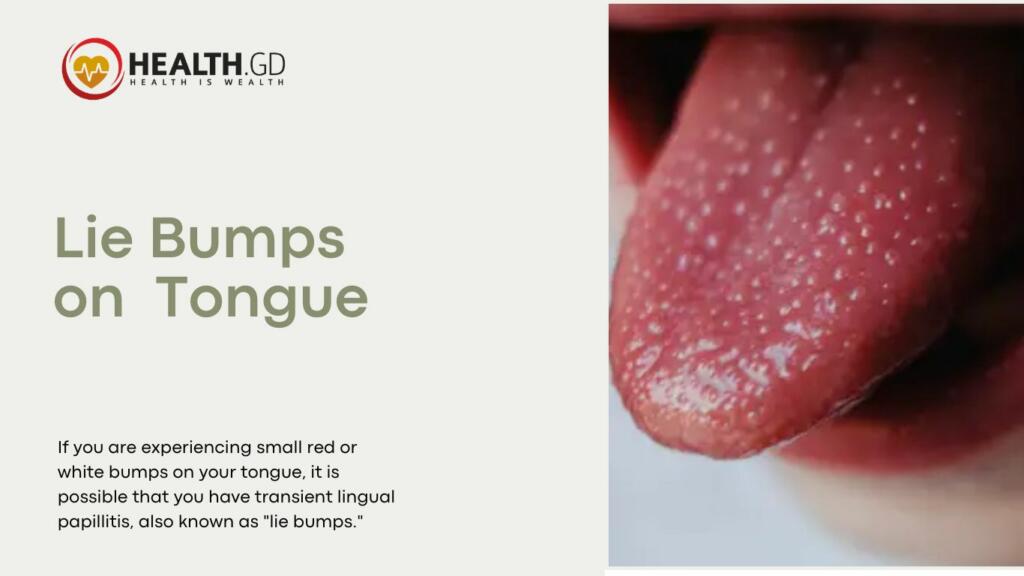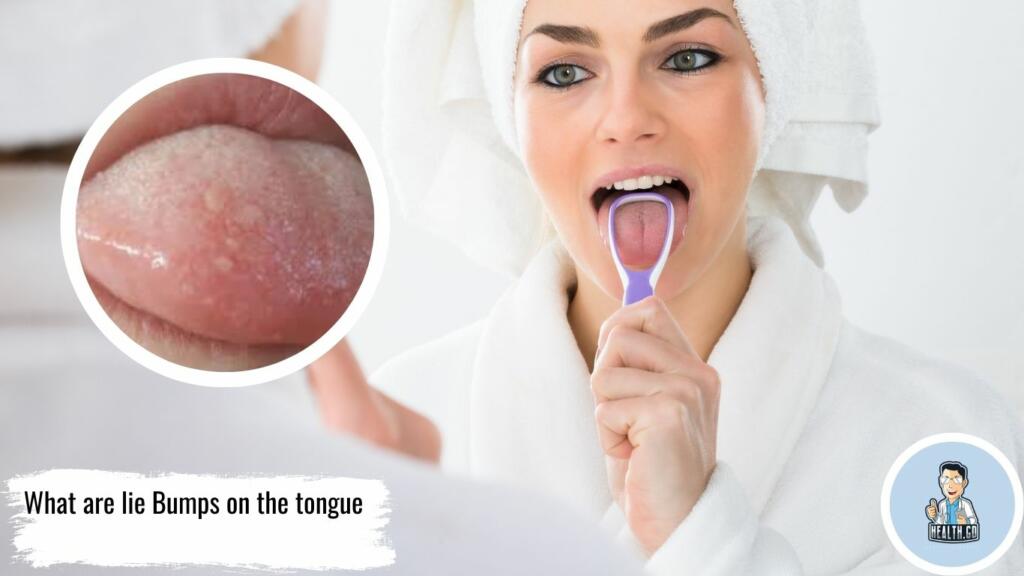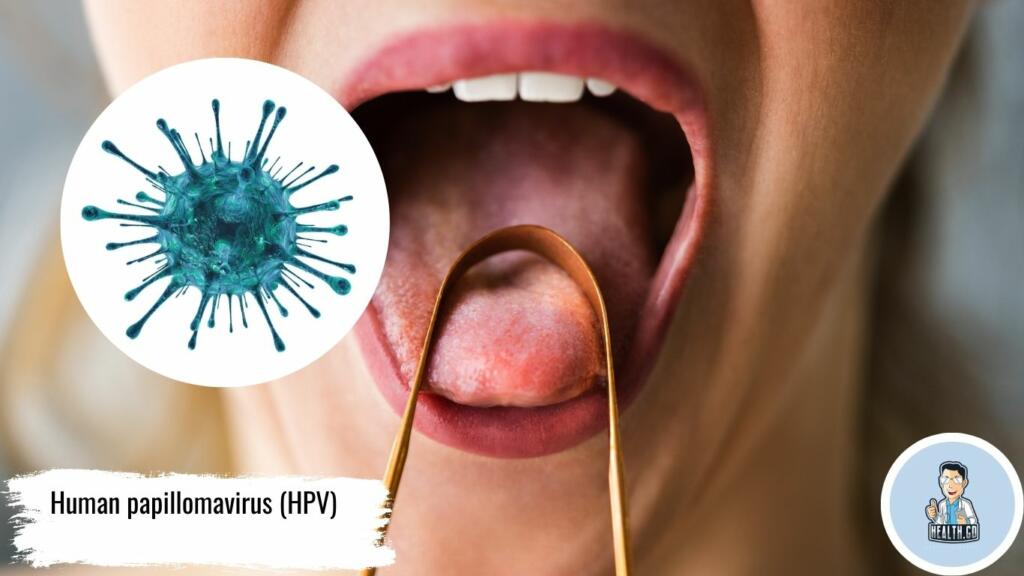I understand that you are feeling worried about the bumps on your tongue, which is a common concern for many people.
The small bumps on your tongue are called fungiform papillae. They help to house taste buds and secrete saliva and are also responsible for the rough texture of the tongue, which helps you to eat.

There are three types of papillae: fungiform, filiform, and circumvallate. The circumvallate papillae, which are located at the back of the tongue, are the ones that people often ask about. They may look larger and weirder than the rest of the papillae, but they are normal and house hundreds of taste buds.
Sometimes the papillae can become inflamed or infected and can become enlarged, leading to soreness or irritation. If you are experiencing small red or white bumps on your tongue, it is possible that you have transient lingual papillitis, also known as “lie bumps.” This condition is a short-term issue that affects the tongue and can cause some pain and discomfort.
Most irregular bumps on the tongue are not concerning, especially if they are on both sides of the tongue. However, if you have something that looks weird and it’s only on one side and it’s not going away, it’s more likely that it’s not supposed to be there. This could be caused by canker sores, oral thrush, acidic food and drink sensitivities, smoking, stress, allergies, or, in extreme cases, STDs and STIs, or oral cancer.
Canker sores and Aptus ulcers may show up anywhere on the tongue, and while they are painful, they go away in seven to ten days without treatment. On the other hand, sexually transmitted infection (STI) such as syphilis requires antibiotics to treat the painless sore. Scarlet fever is another condition that causes the tongue to become red, bumpy, and swollen, which can be treated with antibiotics.
Some tongue bumps may be cancerous and indicate mouth cancer, so it is important to get a biopsy and seek treatment with radiation therapy or chemotherapy if required. Other conditions that may cause tongue bumps are glossitis due to inflammation, traumatic fibroma due to chronic irritation of the tongue, and lymphopithyl cysts which appear underneath the tongue without any known cause.
what is a lie bump on the tongue?
A lie bump, also known as transient lingual papillitis, is a small, painful, red or white bump that appears on the surface of the tongue. Despite the name, lie bumps are not caused by lying or dishonesty. They are a common and mostly harmless condition that can affect people of all ages.
While these bumps may be painful, they are common and usually go away on their own within 2 or 3 days without any specific treatment.
Symptoms of Lie Bumps

Lie bumps can cause small bumps on the tongue that look like pimples. These bumps may feel uncomfortable, painful, swollen, itchy, or tingly.
Aside from pain or irritation caused by the bumps, people usually do not experience any other symptoms.
Causes of Lie Bumps on the Tongue
I understand that you have concerns about bumps on your tongue and that you may be worried about what could be causing them.
Improper Diet
There are a few factors that are thought to play a role in transient lingual papillitis, such as diets high in acidic foods or sugar, spicy foods, stress, and inflammation, biting the tongue, burning the tongue, digestive problems, and food allergies.
While transient lingual papillitis is a common cause of bumps on the tongue, there are other potential causes to consider.
Human papillomavirus (HPV)

One possible cause of bumps on the tongue is the human papillomavirus (HPV). This viral infection can be spread through skin-to-skin contact and may cause warts in the mouth or throat. Another potential cause is canker sores, which are red, painful sores that can appear anywhere in the mouth and usually heal on their own within 10 days.
Syphilis, A Sexually Transmitted disease
Syphilis, a sexually transmitted infection, can also cause sores in the mouth that may appear as bumps on the tongue. Scarlet fever, a bacterial infection, may cause the appearance of red bumps on the tongue as well. It is also possible that bumps on the tongue may be a sign of mouth cancer, although this is rare. If the bumps are grey, pink, or red and bleed when touched, it is important to see a doctor to rule out this possibility.
Traumatic Fibroma
Another potential cause of bumps on the tongue is traumatic fibroma, which is a smooth, pink growth that can appear on the tongue due to chronic irritation. In some cases, surgical removal may be necessary. Lastly, lymphoepithelial cysts are soft, yellow cysts that may appear under the tongue. They are typically harmless, and the cause is unknown.
Canker Sores
Canker sores are one of the most common causes of mouth sores and can appear on the inside of the lips, cheeks, and tongue. They can be red, white, or yellow in appearance and can feel raw and painful.

While the exact cause of canker sores is still not fully understood, certain foods may trigger them in some people. It may be helpful to keep a food diary and note any foods that seem to make your canker sores worse. Common triggers include spicy or acidic foods, as well as foods that are high in sugar.
Most canker sores will go away on their own within a few days or weeks, but some can be very painful and may require medical attention. If you have a canker sore that is especially painful or does not seem to be healing, it is important to see a doctor or dentist for a proper evaluation.
Food allergies
you may be experiencing bumps or swelling on your tongue due to food intolerance or allergic reaction. This can be a serious issue, especially if it is accompanied by other symptoms such as swelling of the lips, mouth, or tongue, a sudden rash or hives, or wheezing or difficulty breathing.
If you are experiencing any of these symptoms, it is important to seek immediate medical attention. These could be signs of a dangerous reaction known as anaphylaxis, which requires immediate treatment to prevent serious complications. Anaphylaxis is a severe allergic reaction that can cause difficulty breathing, a drop in blood pressure, and shock.
Mouth Cancer
you may be feeling anxious and concerned about the bump on your tongue, especially after reading about the possibility of it being cancerous. Keep in mind that while a bump on the tongue can be a sign of cancer, this is a rare occurrence. There are many other potential causes for bumps on the tongue, such as canker sores or infections. However, it is always best to err on the side of caution and consult with a doctor if you notice any lump or bump that lasts longer than a week or two.
Infection Inside Mouth
Experiencing pain and swelling in your mouth or on your tongue could include infections or injuries. Regardless of the cause, it is important to seek medical attention if you are experiencing significant discomfort.
One possible cause of swelling and pain in the tongue is an infection. Even in a healthy mouth, there are many bacteria present, and any injury can make it easier for bacteria to enter the tissues of the tongue.
In some cases, swelling and pain on the tongue may be the result of an injury such as biting your tongue or sustaining trauma to the mouth. While these injuries are usually not serious, it is still important to seek medical attention if you experience significant pain or if the swelling does not go down within a reasonable amount of time.
Yeast Infection in Mouth
If you’ve noticed white patches on your tongue or lips, redness, soreness, or a cottony feeling in your mouth, you may be experiencing oral thrush. Oral thrush is a type of yeast infection that commonly occurs in the mouth.
Babies, particularly newborns, are especially susceptible to oral thrush. However, there are other risk factors that may increase your chances of developing oral thrush. These include having diabetes, using corticosteroids (including asthma inhalers), having a weakened immune system due to conditions such as HIV, organ transplantation, autoimmune diseases, and cancer, or taking medications that cause dry mouth.
Your healthcare provider may prescribe antifungal medication to treat the infection. It is important to practice good oral hygiene, such as brushing your teeth and tongue regularly, to prevent further infections from developing.
Lungs Infection such as TB
Tuberculosis (TB) is an infectious disease that primarily affects the lungs, but in some cases, it can cause lesions and sores on the body, including the tongue. While tongue lesions due to TB are rare, they may be the first sign of the disease in a newly infected person.
Other Causes
In addition to the factors mentioned previously, other lifestyle factors that may increase the risk of developing tongue bumps include stress, lack of sleep, poor nutrition, consumption of sour or acidic foods, and smoking.
Various health conditions can also be potential risk factors, such as eczema, allergies, geographic tongue, gastrointestinal disorders, and asthma. If you have any of these conditions, it’s important to take extra care of your oral health and speak with your healthcare provider about any concerns you may have about tongue bumps or lesions.
Diagnosis of Lie Bumps on the Tongue

If you are experiencing persistent and painful lie bumps on your tongue that have not gone away after a week, it may be a good idea to make an appointment to see your doctor or dentist. Children who experience recurring and painful lie bumps should see their pediatrician.
For less severe cases, it’s generally safe to wait a few days before seeing a doctor unless the bump is causing intense pain or you have a fever. If the symptoms persist longer than a week or if the bump grows and does not go away, it’s best to speak to a doctor. Additionally, painful tongue bumps that keep coming back should also be evaluated by a doctor.
To diagnose the bumps, a doctor will ask about your medical history and any food allergies. In some cases, they may order a blood test to rule out infections such as syphilis and tuberculosis. If cancer is suspected or the cause of the bump is unknown, a biopsy or removal of the lump may be recommended for diagnosis.
Then they will examine the bumps and may diagnose them on appearance alone. However, if they are unsure whether the bump is a lie bump or caused by another condition like human papillomavirus (HPV), they may need to perform a biopsy. To do this, they will likely numb the area with a local anesthetic and remove a small section of the bump to test and examine under a microscope.
How to Prevent Lie Bumps on the Tongue?

Practicing good oral hygiene is important for preventing many oral conditions, including lie bumps. Be sure to brush your teeth at least twice a day and don’t forget to brush your tongue. Consider using other helpful products such as an antimicrobial mouth rinse and tongue scrapers. It’s also important to see your dental professional for regular appointments. Sharp-edged teeth and restorations could cause your lie bumps, which your dentist can easily correct.
Learning interesting facts about the tongue can also be beneficial for well-rounded oral care.
It’s important to remember that lie bumps tend to go away on their own and are generally harmless. While the exact cause of lie bumps is not always known, practicing good oral hygiene can help prevent many oral conditions.
Treatment of Lie Bumps on the Tongue
The treatment for tongue bumps depends on the underlying cause. For example, antifungal medications may be used to treat oral thrush, while bacterial infections will often require antibiotics.
One thing that can be helpful is to avoid acidic or spicy foods, as these can irritate the tongue and make the bumps more uncomfortable. Instead, opt for softer, blander foods until the condition resolves. Rinsing your mouth with salt water can help to reduce inflammation and promote healing. Try mixing half a teaspoon of salt into a glass of warm water and swishing it around in your mouth for 30 seconds before spitting it out.
Maintain good oral hygiene by brushing your teeth after every meal. This can help to remove bacteria and debris from the mouth, which can contribute to the formation of lie bumps. Using mouthwash can also be helpful in reducing bacteria in the mouth and promoting oral health.
Some conditions, such as lie bumps, may clear up on their own, while herpes is not curable but antiviral medications can help prevent further outbreaks. Other medical conditions that weaken the immune system and make tongue bumps more likely may also need to be addressed, such as testing for diabetes. Proper management of these conditions can help reduce the risk of tongue bumps returning.
Finally, individuals up to the age of 26 should consider getting the human papillomavirus (HPV) vaccine, as HPV is the virus linked to oral and genital cancer.
Over-the-counter topical treatments can be effective in reducing discomfort and promoting healing. Look for treatments that contain ingredients like benzocaine or hydrogen peroxide, which can help to numb the affected area and reduce inflammation.
Home Remedies to Cure Lie Bumps
While medical treatment is important, there are also some home remedies that may help to reduce the discomfort associated with tongue bumps. These include avoiding acidic and spicy foods until the bumps disappear, drinking plenty of water, and gargling with warm salt water or baking soda mouth rinses on a regular basis. Additionally, topical remedies such as canker sore medication or oral numbing gels may help to reduce pain. It’s important to avoid alcohol-based mouthwashes until the bumps disappear, as they can further irritate the area. A range of non-alcohol mouthwashes is available online.
Practicing good oral hygiene is also important in reducing the risk of tongue bumps and cancer, as well as preventing bumps from getting infected or becoming painful. This includes brushing your teeth twice a day, flossing at least once a day, seeing your dentist twice a year, rinsing your mouth thoroughly after using steroid inhalers, avoiding foods that irritate the gums, limiting sugary snacks and foods that can cause tooth decay, quitting smoking and avoiding using chewing tobacco or similar products, and treating any underlying health problems, such as diabetes.
Why do I see Spots on the tongue?
I understand that you are concerned about various spots or conditions that can appear on the tongue and how they might be affecting you.
- Canker sores – Yellow or white spots with red borders.
- Cold sores – Blisters or fluid-filled bumps, sometimes in clusters.
- Geographic tongue – Discolored, map-like spots that may have a light-colored border.
- Lie bumps (transient lingual papillitis) – Small red or white bumps.
- Oral thrush – Raised, white areas that resemble cottage cheese.
- Lichen planus – White, lacy patches with possible redness and swelling.
- Leukoplakia – White patches that won’t scrape off.
- Erythroplakia – Red patches that won’t scrape off.
- Tongue cancer – Red or white patches, ulcers or open sores.
I hope that helps clarify the different conditions and their appearances.
What are the Types of Bumps on the Tongue?
Localized Lingual Papillitis Type
classic or localized transient lingual papillitis. It can be distressing to experience painful bumps on your tongue and other associated symptoms, such as a burning or tingling sensation, sensitivity to hot foods, and distorted taste.
It is important to remember that this condition is usually benign and self-limiting, which means that it will go away on its own within a few days. However, there are a few things that you can do to manage your symptoms and feel more comfortable while you are experiencing them.
Firstly, try to avoid eating foods that are spicy or high in acid, as these can irritate the bumps on your tongue and make your symptoms worse. Stick to soft, bland foods that are easy to eat, such as soups, mashed potatoes, and smoothies.
You may also find it helpful to rinse your mouth with salt water or a mild antiseptic mouthwash to help soothe the inflamed area. Drinking plenty of water can also help to keep your mouth moist and alleviate the discomfort of a dry mouth.
Eruptive Lingual Papillitis Type
Eruptive lingual papillitis can be a distressing condition, causing painful bumps on the tongue, fever, enlarged lymph nodes, excess saliva, and difficulty eating.
It is important to note that this type of lingual papillitis usually affects children and is typically a self-limiting condition that lasts for about a week. The best course of action is to focus on managing the symptoms and providing supportive care to help your child feel more comfortable.
You can try giving your child soft, bland foods that are easy to swallow, such as soup, mashed potatoes, and smoothies. Encourage them to drink plenty of fluids to stay hydrated and to help alleviate dry mouth. You can also try rinsing their mouth with salt water or a mild antiseptic mouthwash to help soothe the inflamed area.
If your child’s symptoms are particularly severe or persistent, or if they develop a high fever or difficulty breathing, it is important to seek medical attention immediately. Your doctor may recommend over-the-counter treatments such as topical gels or oral analgesics to help relieve pain and discomfort.
Papulokeratotic Lingual Papillitis Type
papulokeratotic lingual papillitis can cause white or yellow bumps on the tongue that may persist for long periods of time. While these bumps are often painless, they can be concerning and uncomfortable.
It is a benign condition that does not typically require medical treatment.
U-Shaped Lingual Papillitis
U-shaped lingual papillitis may cause small patches of the tongue to appear peeled away, along with scattered pink spots, tongue swelling, burning sensations in the mouth, and canker sores on the cheeks, lips, and mouth. It is important to note that this type of papillitis may be associated with COVID-19.
It is recommended that you get tested for COVID-19 and follow any guidelines provided by your healthcare provider. If you test positive, it is important to isolate yourself and follow the recommended protocols for managing your symptoms and preventing the spread of the virus.
When to See a Doctor?
If you suspect that you have an infection, it is important to see a doctor as soon as possible. This is particularly true if the bump is very painful or if you have a fever, as these could be signs of a serious infection that require immediate attention.
if you have a sore bump on your tongue that lasts longer than 14 days and is only on one side, it’s time to visit your dentist for an exam to find out why it’s not healing.
If the bumps don’t go away after a while and start to spread and grow, it is important to see a doctor to avoid any difficulty in eating.
The only cause of tongue bumps that is a medical emergency is anaphylaxis. If you experience a very swollen tongue or breathing problems alongside your tongue bumps, it’s essential to seek immediate medical assistance.
If you have been exposed to TB and notice any unusual lesions or sores on your tongue or elsewhere on your body, it’s important to seek medical attention immediately. TB is a serious condition that requires prompt diagnosis and treatment.
Related Topics:
Torus Palatinus Pictures, Symptoms And Treatment
All About Chipped Tooth Repair Kit You Should Know
13 Reasons Why You Need A Dentist Consultation
Alum Powder For Canker Sore? Step By Step Guide
Why Do I Keep Biting My Tongue
What Are Tongue Piercing Pros And Cons?
Cavity: How Long Can You Leave It Untreated?
3 Ways For Pain Relief After Dental Surgery
What Does A Cavity Look Like And How To Locate It?
Conclusion
Lie bumps on the tongue are a common, yet uncomfortable, oral health issue that can be caused by various factors, such as trauma, stress, food allergies, and hormonal imbalances. While they typically resolve on their own within a week, there are several treatment options available to alleviate the pain and discomfort. Maintaining good oral hygiene, managing stress, and avoiding potential irritants can help prevent the development of lie bumps.
FAQ
Are lie bumps contagious?
No, lie bumps are not contagious and cannot be spread from one person to another.
Can lie bumps turn into something more serious?
In most cases, lie bumps are harmless and resolve on their own. However, if they persist or worsen, it’s essential to consult a healthcare professional to rule out any underlying conditions or complications.
Do lie bumps only occur on the tongue?
While lie bumps are most commonly found on the tongue, they can also appear on other areas of the mouth, such as the inner cheeks or gums.
Are there any long-term effects of lie bumps?
Lie bumps usually have no long-term effects and heal completely once they resolve. However, recurrent lie bumps may cause discomfort and impact daily activities like eating and speaking.
Can children also develop lie bumps?
Yes, children can also develop lie bumps. In most cases, the same treatment options and prevention tips apply to both children and adults.








